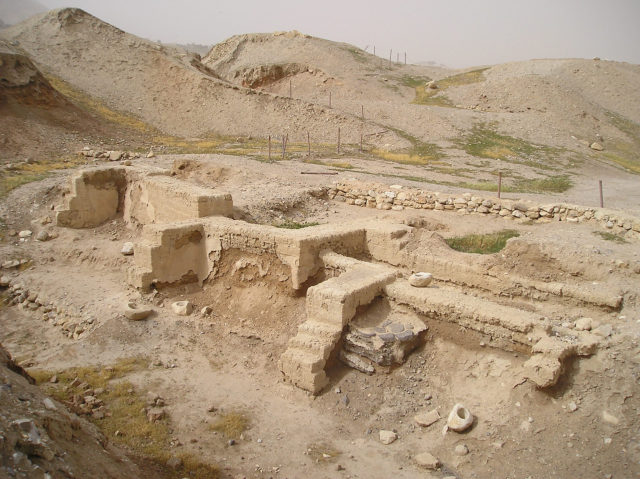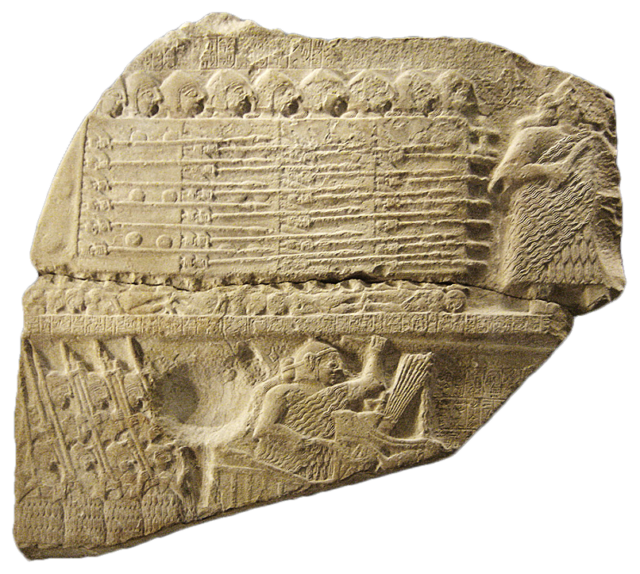Our understanding of ancient warfare is hazy. Written accounts are few and limited in scope. The emergence of war from inter-personal violence is shrouded in a historical fog. The work of historians and archaeologists has allowed us to pierce that fog a little.
Stone Age Art of War
The earliest hints at a record of warfare come from late stone-age cave paintings in SE Spain. For the first time, these show bows and arrows being used against other groups of people instead of animals.
With no other evidence, we do not know how organized this violence was – whether it involved armies or tribal raids. We also do not know how long it had been going on. We can see that, by then, groups of humans were turning weapons on each other.
Defenses at Jericho
The walls of Jericho, famous for their fall in the Old Testament, were among the first great defensive works in the world. Built around 8000 BC, this place in the Jordan Valley was defended by a stone circuit wall and a deep ditch. A circular bastion with a staircase in its center allowed warriors to ascend and defend the walls.
Around the same time, increasingly sophisticated arrow heads were being made in the Near East. This was happening just as hunting was becoming less important, and likely reflects the needs of warfare.

A Town Built for Defense
Çatal Hüyük, a town in Turkey, appears to have been built entirely with defense in mind. A well-established settlement by 6500 BC, its buildings had no way in on the ground floor. The flat-roofed houses were piled up side by side with rooftop entrances and ladders down into the interior. Once ladders were pulled up from the outside walls, any attackers would have faced a blank wall with no way in.
Death at Hambledon Hill
Evidence from Hambledon Hill in Dorset shows that by the third millennium BC war had reached the British Isles. This hillfort settlement had layers of defenses built over the centuries including timber-fronted ramparts. Large parts of these ramparts were burned down during an attack and bodies have been found in the excavations. These include a young man shot with an arrow as he tried to carry a baby to safety.
This and other archaeological evidence of war comes only a few centuries after agriculture arrived in Britain. It seems to indicate this created pressures on the population and resources, leading to violent confrontations.
The Beginning of Warrior Burials
Around 2000 BC, the status of men as warriors had become important enough to influence the way they were buried. Polished stone battle-axes and copper daggers have been found in graves, indicating the martial standing of the deceased.
Memorialising Triumphs
By the middle of the third millennium BC, rulers in Egypt and Mesopotamia were recording their military victories so they could be celebrated by future generations. These accounts are written in general terms and designed to throw the best light on the victors. As a result, we do not have details of how the battles were fought, and the accounts need to be treated as biased.

The First Disciplined Infantry?
The first evidence for organized, disciplined infantry formations comes from the Sumerian city-states. During the second half of the third millennium BC, they fielded armies in extended campaigns, conquering each other and neighboring areas.
The depictions of their wars show formations of infantry with matching equipment, split into light and heavy infantry. Groups of spearmen thrust their weapons out through the gaps between shields. This was the first precursor of the phalanxes that would become so important to Mediterranean and Middle Eastern warfare.
First Chariots
The Sumerians also deployed the first predecessor of the chariot. This heavy, clumsy battle wagon was drawn by a team of four animals. It was probably slow moving and lacking in agility compared to later developments.
Continuity of Weaponry
The first thousand years of organized warfare, from the rise of the Sumerian city-states, saw lots of continuity in the weapons used. Three weapons, in particular, were used by most soldiers throughout the era and across the Middle East.
First were heavy spears, utilized in the early phalanx-like formations.
Second were battle axes. These had rounded blades designed to pierce armor and damage flesh, instead of the flat-edged blades of wood-chopping axes. The blacksmiths of the 3rd millennium showed great sophistication in developing new designs for their axes and new techniques with which to forge them.
Thirdly, there were daggers. At first simple, these became increasingly elaborate in their decoration through the use of bivalve molds.
The Arrival of Armor
Leather body armor and metal helmets were in use in the 3rd millennium BC, as part of the early stages of organized warfare. It was in the second half of the second millennium that the first metal body armor appeared, in the form of chainmail shirts.
Bows Gain Status
Another change at this time was a rise in the importance and prestige of bows. These had rarely been depicted in victory monuments before this time. Rulers of Egypt were shown wielding bows on important monuments, demonstrating this was not just an important battlefield weapon, but one prestigious enough to be used by a king.
Part of this came from the development of more powerful composite bows. Such bows had existed for centuries, but their design shifted in the 2nd millennium, making them more useful in war.
Armageddon
The word “Armageddon” comes from one of the earliest battles to be recorded in any detail. Around 1485 BC, the Egyptian pharaoh Tuthmosis defeated a coalition of his opponents led by the City of Megiddo and then took the City by siege. The battle became a by-word in the region for destructive conflict.
Source:
General Sir John Hackett, ed. (1989), Warfare in the Ancient World.
